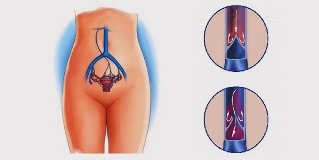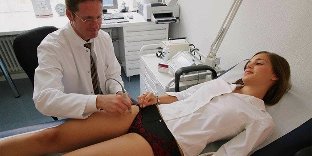In this article you will learn: why varicose veins of the pelvis is considered to be a separate disease, not a variety of varicose veins feet; who have this disease can occur and why. Manifestations and diagnosis of its pathology, how it correctly to treat, the chances of recovery.

Varicose veins of the pelvis – this weakening of the wall for indoor or outdoor veins and blood vessels in the pelvic region, which leads to too expand in their diameter. Varicose changes of the vein is not able to ensure the blood outflow from pelvic inflammatory disease, which leads to the stop and the complete destruction of the vascular walls. The result – a violation of the structure and functions, and female genital system.
Initially, the disease only causes small discomfort in the abdominal area of the external genitalia, and under the belly. Women work in the form of pelvic varicose veins torment yourself constantly strong pains, various gynecological diseases, useless, it is a cosmetic defect in the form of convoluted extended to the veins and nodes of perineum, genital lips or the entrance of the vagina.
The disease can be completely cure, but to prevent the relapse of the necessary life-long prevention. Dealing with this problem jointly by the vascular surgeons akušöör-gynecologists.
Varicose veins of the pelvis in men as in women does not happen. But such a disease exists – varicocele. The mechanisms of the emergence and the signs are similar so if the pelvic varicose veins. Varicose veins present in the left testicle and on-the-go seed the umbilical cord due to the fact that the left vienna in the testicles stand in the blood. He is thrown back into the lower compartment out of the left renal vein, which flows into the way.
The main pathology of how serious it is
External and internal female genital organs well krovosnabjaemah. In order to ensure adequate blood outflow from the powerful need of the network of veins and blood vessels. Therefore, it is deoxygenated system of the pelvis in women is well developed. Each of the five are strong, the walls are equipped with valves, connected to (in passing veins. All of this represents the coordinated work of the venous network in the pelvic region which collects blood perineum, external genital organs (vulva, vagina), special structures (ovaries, uterus) and transports it to a lower Polow vein.
Varicose changes of the vein in the pelvis different from the healthy so that they:
- The expanded diameter;
- Crowded with blood;
- Too convoluted;
- Are protrusions in the form of sites;
- Flabby and weak.
Pelvic vein, damaged veins, can collect the blood in the external genital and other organs, but not able to normally carry, the larger vessels (hollow vein). This lead to the blood to stand in the bowl, and penetrating through the venous wall, hitting these fabrics, which should be no. They become swollen, inflamed and lose their function.
But most are varicose veins of the pelvis dangerous:
- The various violations of the ovaries;
- Uterine bleeding and different disorders;
- Fertility, pregnancy cut the risk of and you natural childbirth;
- Education of blood clots the formation of a lumen of the varicose changed veins, which threatens their stock in the place of education and migration to the heart and the blood vessels of the lungs. This is the most dangerous complication, life-threatening – thromboembolism of the pulmonary arteries (PE).
Reasons
Mainly are varicose veins of the pelvis is sometimes the adult women:
- Up to 20 years – 20%;
- 20-30 years – 30%
- 30 – 45 years – 50%
Mechanisms of varicose the revival of the venous system of the pelvis:

- (80%). They are the largest of the trunk veins, which collect blood from the uterus and the ovaries and carries it directly to the hollow (the best) or kidney (left) vein. If them occurs a failure, it completely locks the venous outflow.
- A single of the weakening or destruction of the venous walls all the pelvic veins – all of them simultaneously expanding and is not able to shrink in order to push the blood in the overlying departments.
- Reverse throw blood in the deep vein of the hips to the surface the sexual vein, which is a collection of blood inside of the leg and of the external genitalia, prevents the large outflow. The result is pressure on her to rise, and its trunk and all of the tributary varicose swell.
Direct causes is to run such mechanisms may be such:
- Congenital weakness or dysplasia (underdevelopment) of venous walls and valves.
- Hormonal adjustment of the female body (puberty, pregnancy, menopause, diseases, ovarian).
- Frequent inflammatory processes, endometriosis surgery, the adhesive process in a bucket.
- Move thrombosis and thrombophlebitis of the pelvic veins.
- The hard physical work.
- Long stay lying or sitting down.
- Overweight.
- Pregnancy and childbirth.
- Regular interrupt intercourse over the years, especially if there is no orgasm.
- Bends of the uterus posteriorly or in front.
- Tumors of the pelvis.
- Sagging of the uterus.
The degree of varicose veins – classification
Is the anatomical basis of (prevalence of) varicose veins of the pelvis are distinguished three types:
- Venous plethora of the bucket;
- Perineal varicose veins, etc.;
- The combined form.
To reflect the nature of the abnormal changes of the disease are distinguished in three steps:
- The first is the enlarged blood vessels of any organ plexus or pelvic do not exceed a diameter of 0.5 cm, too convoluted.
- The second – the diameter of the veins increases of up to 1 cm, the process has spread not only to plexus organs(uterus, ovary), but those around you (okolomatocnah cellulose).
- The third – expansion (ectasia) of more than 1 cm would affect all ships – intraorganic, about the bodies and the trunk (trunk of ovarian vein).
Greater the disease, the worse are the enlarged veins and harder to stagnation of blood in the bowl.
Characteristic symptoms
Women who have varicose veins of the pelvis note:
- Persistent or recurrent pain in the abdomen, strengthening existing evening or after the load is predominantly in the second half of the cycle (closer to a month). If there is 3 degrees, the pain can be very strong.
- Itching, burning, swelling and cyanosis of the reproductive organs.
- Painful menstruation and sexual intercourse.
- Abundant menstruation and uterine bleeding, irregular cycle.
- The inability to get pregnant.
- Thickened convoluted vein perineum region and häbememokad.
- Frequent painful urination.
- Brightly expressed manifestations of premenstrual syndrome.

Diagnostics
To confirm the diagnosis of conduct:
- ULTRASOUND through the abdomen and through the vagina (transvaginal) using special sensors – Doppler and duplex-the treatment of varicose veins of the pelvis. The easiest and most informative method.
- Veresoonesisese for phlebography – introduction to special medication ovarian vein.
- Computed tomography with enhancement.
- A diagnostic laparoscopy.
Treatment
Varicose veins of the pelvis common to treat a cardiovascular surgeon or obstetrician-gynecologists. According to the views of treatment consists of such destinations:
- Normalization lifestyle;
- Conservative medical treatment;
- Packing and other therapy;
- Surgical treatment.
Treatment of varicose veins of the pelvis can be. To this end, are specialists in forming of the individual treatment plan and sick women should for life stay in the medical-preventive recommendations.
1. Normalization lifestyle
Because of wrong way of life serves the premise and the direct cause of varicose to expand the pelvic veins, this normalization can help treat:
- Avoid long stay standing or sitting (more than 2-3 hours without a break).
- Do not raise the weight and out heavy physical work.
- Days must perform the unloading of the exercises to the pelvic (exercises kask, bike) or just lie down for 10-15 minutes with elevated above the body of the sink.
- Reduce body weight (as obesity).
- Do not take a hot bath, replace it with a cool shower.
- Out alcohol and smoking.
2. Medical treatment
Treatment of varicose to expand the pelvic veins to any degree is not possible without medical assistance. If the first instance of this is the main treat of the event, if the second and third complements the comprehensive treatment.
The use of such medications:
- Special preparations strengthen the venous blood vessels.
- Anticoagulants – liquefy the blood, to facilitate its promotion of the ships.
- Drugs that improve the microcirculation.
Additional group of medicines for taking into account the existing differences in the body:
- Medications female hormones (if dishormonal disorders).
- Analgesics and anti-inflammatory tools.
- Medicines to stop blood styptic medication to treat uterine bleeding.
3. Compression therapy
One of the most effective tools in the treatment of varicose veins in the area of the vulva and perineum is the compression effect. Principle of the method is similar to the use of elastic ties, varicose veins feet. Pressure to vital organs (compression) of the superficial veins from the outside would contribute to their emptying blood. To create this kind of effect is able to special tights or shorts out of the packaging medical knitwear. You can buy specialized pharmacies, stores, lounges health care products, separately selecting the right size and power to suppress.
Sclerotherapy – puncture varicose expanded veins with the introduction of the lumens of specific medicines, which cause this adhesion. Such treatment shall be made when the outer (subcutaneous) pelvic varicose veins without trauma to the hospital. The internal veins is also possible to cure, but this procedure is technically more complex and takes place under operating conditions.
4. Surgical treatment
Varicose veins of the pelvis better treatment through the activities, if:
- 2-3 extent of the disease;
- The fast pace of the aggravation;
- Planning to become pregnant;
- Expressed pain syndrome;
- Persistent uterine bleeding and other gynecologic disorders.
The main types of operations as pelvic varicose veins:
- Laparoscopic – a special operation through the punctures of the abdomen. Meet ligation in, the intersection or the ovaries removal of the vein. Thus, the elimination of the reverse throw blood on it.
- Delete varicose enlarged veins – through a small puncture or incision of the skin removed, modified subcutaneous vein, tied off in a sexual way to the court from the mouth of the hip the blood vessels.
- Gynecologic intervention – tumors removal, etc., eliminating the wrinkles on the uterus.

Forecast
If at all not to treat varicose enlarged veins of the pelvis, the period of time, they are still more swell (95%), which threatens to dangerous complications. The remaining 5% of women of subcutaneous varicose veins of perineum 1-2 to the extent that it has encountered after giving birth, is a pathology, not leverage, but never along by itself.
If the disease is cured, it is possible to achieve complete recovery (10-50% depending on the degree) or significant improvement (45-50%), especially in the case when the combinations of surgical methods conservative. But in any case, after the integrated treatment must be through the life-long prevention, consist of adherence to recommendations on lifestyle, periodic drug or compression to support weakened veins.






































